Introduction to Microeconomics Homework: Analysis of Markets
VerifiedAdded on 2020/05/28
|15
|2478
|59
Homework Assignment
AI Summary
This microeconomics assignment delves into various aspects of market analysis and economic principles. It begins with an examination of export subsidies, analyzing their impact on prices, consumer and producer surplus, and government revenue within the context of a free trade agreement between Australia and Canada. The assignment then explores the effects of import quotas on market dynamics, including changes in supply, demand, and surplus. The document further discusses trade protection measures, providing arguments for their implementation, specifically focusing on the infant industry argument and business diversification. The assignment also covers the calculation of producer surplus in different scenarios. It analyzes the impact of taxation on inelastic goods, such as Alcopops, assessing the effects on price, quantity demanded, and the distribution of the tax burden. The solution concludes with a discussion of alternative policy interventions, such as quota systems and social reform programs, to address the issues related to taxation on addictive products.
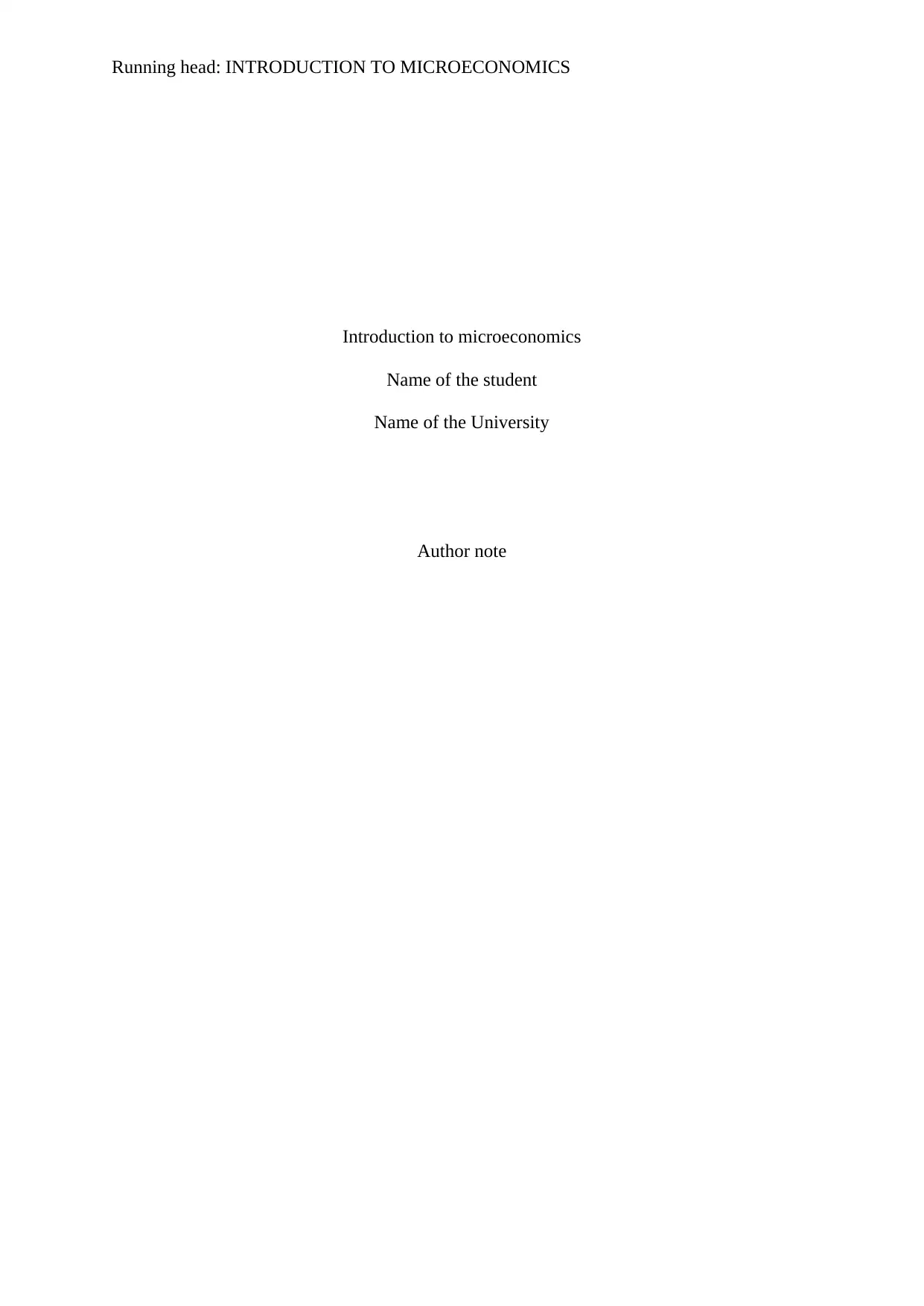
Running head: INTRODUCTION TO MICROECONOMICS
Introduction to microeconomics
Name of the student
Name of the University
Author note
Introduction to microeconomics
Name of the student
Name of the University
Author note
Paraphrase This Document
Need a fresh take? Get an instant paraphrase of this document with our AI Paraphraser
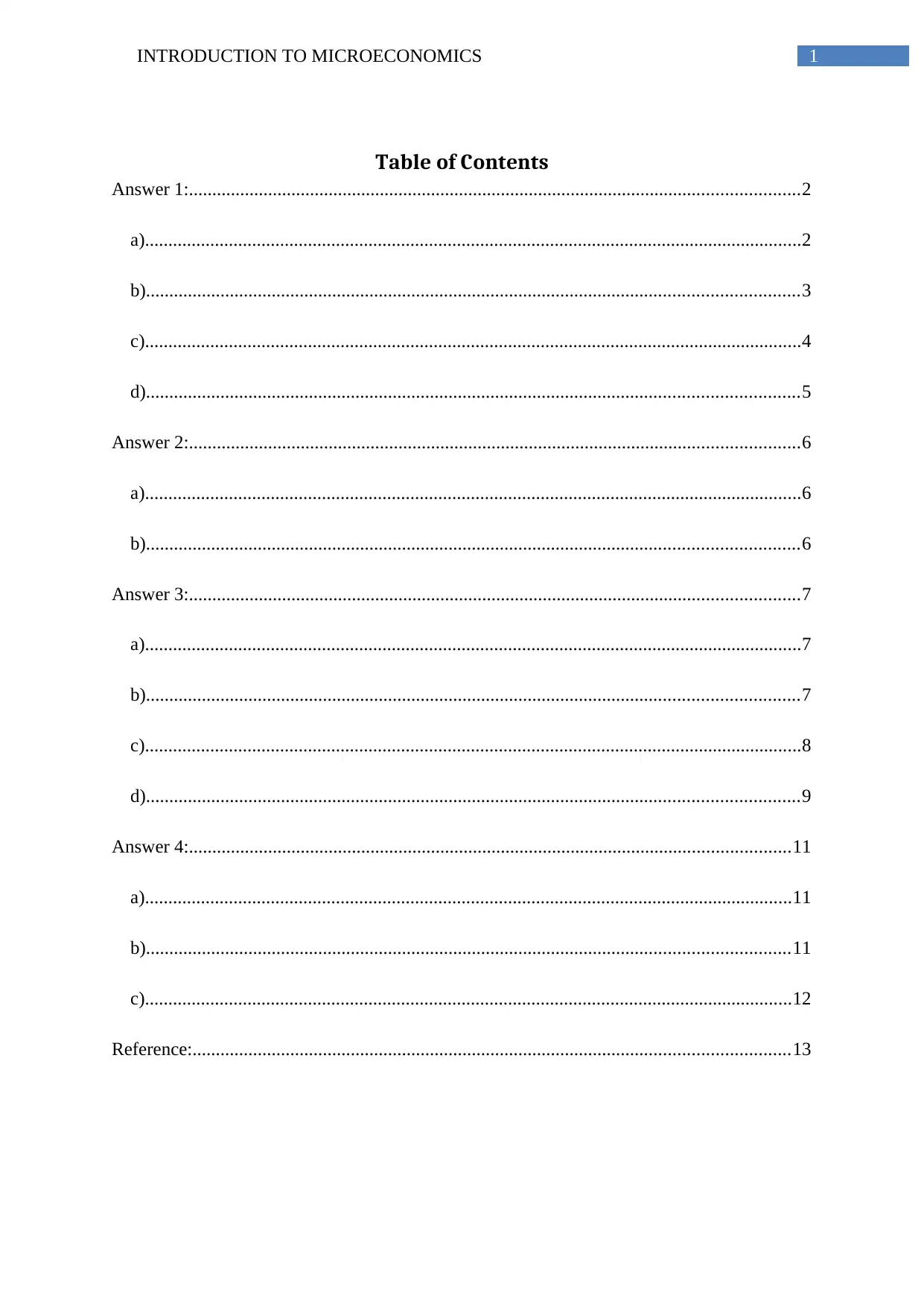
1INTRODUCTION TO MICROECONOMICS
Table of Contents
Answer 1:...................................................................................................................................2
a).............................................................................................................................................2
b)............................................................................................................................................3
c).............................................................................................................................................4
d)............................................................................................................................................5
Answer 2:...................................................................................................................................6
a).............................................................................................................................................6
b)............................................................................................................................................6
Answer 3:...................................................................................................................................7
a).............................................................................................................................................7
b)............................................................................................................................................7
c).............................................................................................................................................8
d)............................................................................................................................................9
Answer 4:.................................................................................................................................11
a)...........................................................................................................................................11
b)..........................................................................................................................................11
c)...........................................................................................................................................12
Reference:................................................................................................................................13
Table of Contents
Answer 1:...................................................................................................................................2
a).............................................................................................................................................2
b)............................................................................................................................................3
c).............................................................................................................................................4
d)............................................................................................................................................5
Answer 2:...................................................................................................................................6
a).............................................................................................................................................6
b)............................................................................................................................................6
Answer 3:...................................................................................................................................7
a).............................................................................................................................................7
b)............................................................................................................................................7
c).............................................................................................................................................8
d)............................................................................................................................................9
Answer 4:.................................................................................................................................11
a)...........................................................................................................................................11
b)..........................................................................................................................................11
c)...........................................................................................................................................12
Reference:................................................................................................................................13
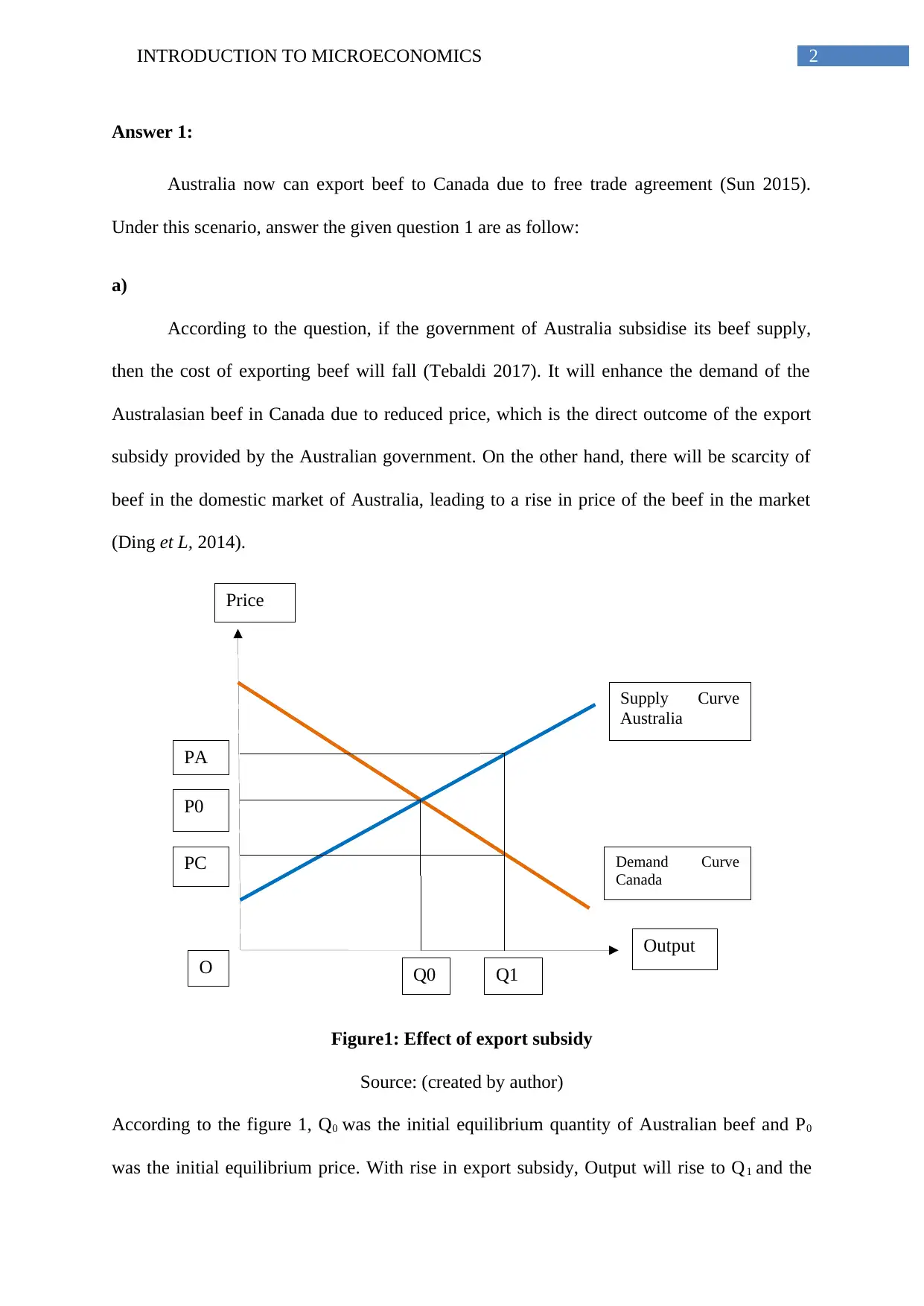
2INTRODUCTION TO MICROECONOMICS
Output
Price
Q0
P0
Demand Curve
Canada
Supply Curve
Australia
PC
PA
Q1O
Answer 1:
Australia now can export beef to Canada due to free trade agreement (Sun 2015).
Under this scenario, answer the given question 1 are as follow:
a)
According to the question, if the government of Australia subsidise its beef supply,
then the cost of exporting beef will fall (Tebaldi 2017). It will enhance the demand of the
Australasian beef in Canada due to reduced price, which is the direct outcome of the export
subsidy provided by the Australian government. On the other hand, there will be scarcity of
beef in the domestic market of Australia, leading to a rise in price of the beef in the market
(Ding et L, 2014).
Figure1: Effect of export subsidy
Source: (created by author)
According to the figure 1, Q0 was the initial equilibrium quantity of Australian beef and P0
was the initial equilibrium price. With rise in export subsidy, Output will rise to Q1 and the
Output
Price
Q0
P0
Demand Curve
Canada
Supply Curve
Australia
PC
PA
Q1O
Answer 1:
Australia now can export beef to Canada due to free trade agreement (Sun 2015).
Under this scenario, answer the given question 1 are as follow:
a)
According to the question, if the government of Australia subsidise its beef supply,
then the cost of exporting beef will fall (Tebaldi 2017). It will enhance the demand of the
Australasian beef in Canada due to reduced price, which is the direct outcome of the export
subsidy provided by the Australian government. On the other hand, there will be scarcity of
beef in the domestic market of Australia, leading to a rise in price of the beef in the market
(Ding et L, 2014).
Figure1: Effect of export subsidy
Source: (created by author)
According to the figure 1, Q0 was the initial equilibrium quantity of Australian beef and P0
was the initial equilibrium price. With rise in export subsidy, Output will rise to Q1 and the
⊘ This is a preview!⊘
Do you want full access?
Subscribe today to unlock all pages.

Trusted by 1+ million students worldwide
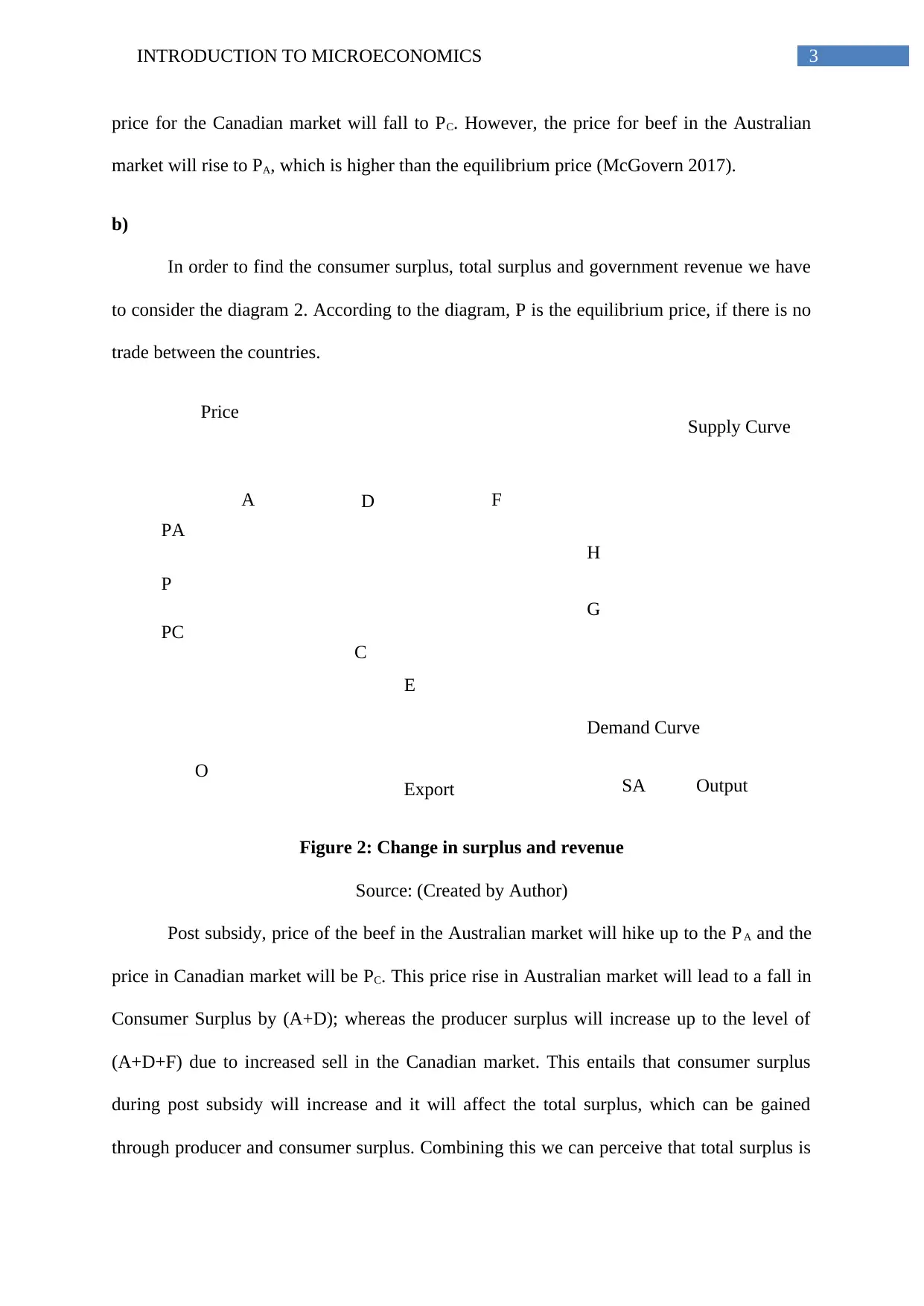
3INTRODUCTION TO MICROECONOMICS
Demand Curve
Supply Curve
Price
Output
O
A
C
D
E
F
G
H
PA
PC
P
SAExport
price for the Canadian market will fall to PC. However, the price for beef in the Australian
market will rise to PA, which is higher than the equilibrium price (McGovern 2017).
b)
In order to find the consumer surplus, total surplus and government revenue we have
to consider the diagram 2. According to the diagram, P is the equilibrium price, if there is no
trade between the countries.
Figure 2: Change in surplus and revenue
Source: (Created by Author)
Post subsidy, price of the beef in the Australian market will hike up to the PA and the
price in Canadian market will be PC. This price rise in Australian market will lead to a fall in
Consumer Surplus by (A+D); whereas the producer surplus will increase up to the level of
(A+D+F) due to increased sell in the Canadian market. This entails that consumer surplus
during post subsidy will increase and it will affect the total surplus, which can be gained
through producer and consumer surplus. Combining this we can perceive that total surplus is
Demand Curve
Supply Curve
Price
Output
O
A
C
D
E
F
G
H
PA
PC
P
SAExport
price for the Canadian market will fall to PC. However, the price for beef in the Australian
market will rise to PA, which is higher than the equilibrium price (McGovern 2017).
b)
In order to find the consumer surplus, total surplus and government revenue we have
to consider the diagram 2. According to the diagram, P is the equilibrium price, if there is no
trade between the countries.
Figure 2: Change in surplus and revenue
Source: (Created by Author)
Post subsidy, price of the beef in the Australian market will hike up to the PA and the
price in Canadian market will be PC. This price rise in Australian market will lead to a fall in
Consumer Surplus by (A+D); whereas the producer surplus will increase up to the level of
(A+D+F) due to increased sell in the Canadian market. This entails that consumer surplus
during post subsidy will increase and it will affect the total surplus, which can be gained
through producer and consumer surplus. Combining this we can perceive that total surplus is
Paraphrase This Document
Need a fresh take? Get an instant paraphrase of this document with our AI Paraphraser
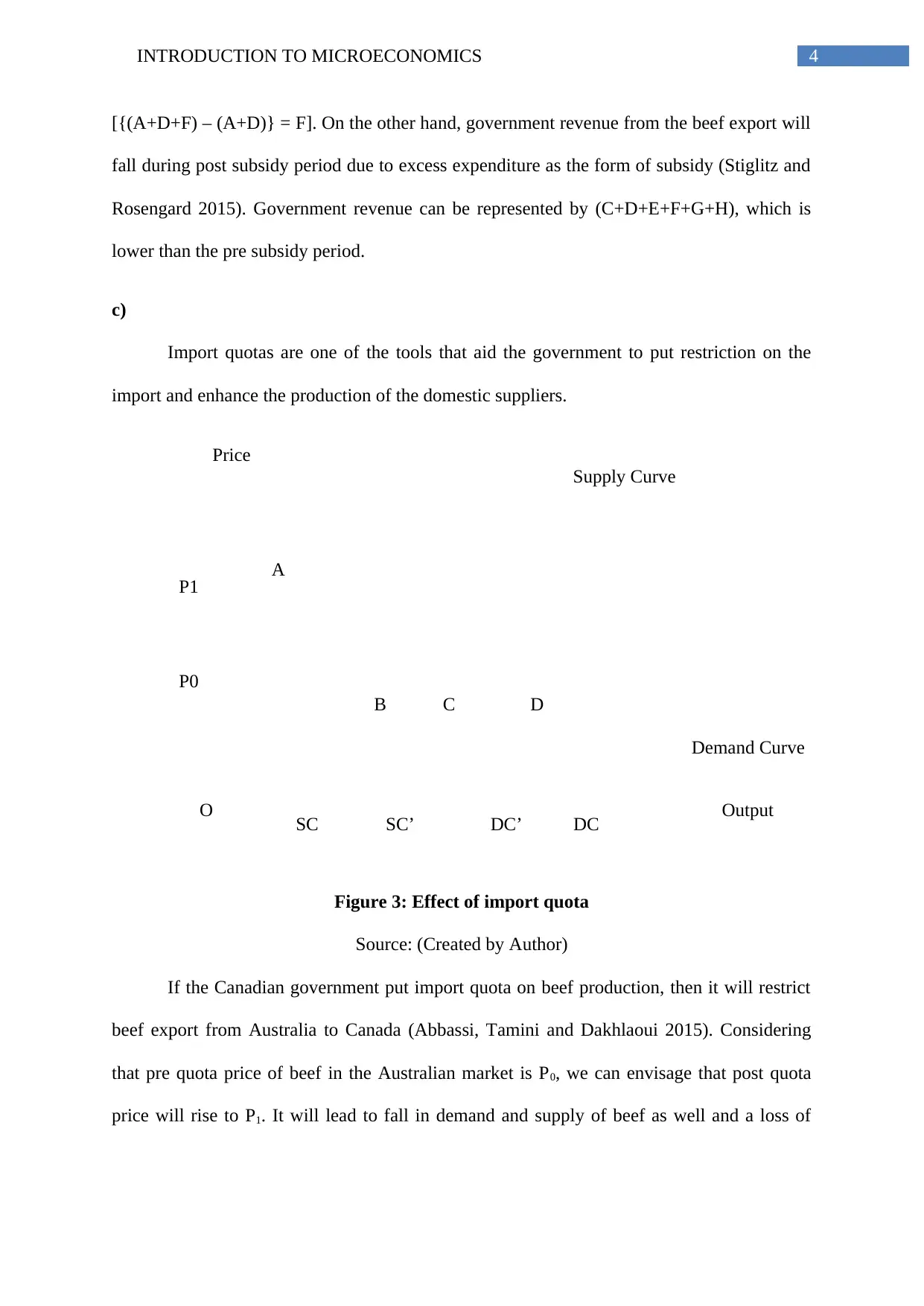
4INTRODUCTION TO MICROECONOMICS
Supply Curve
Demand Curve
P1
P0
O
A
B C D
SC’ DC’
Price
Output
SC DC
[{(A+D+F) – (A+D)} = F]. On the other hand, government revenue from the beef export will
fall during post subsidy period due to excess expenditure as the form of subsidy (Stiglitz and
Rosengard 2015). Government revenue can be represented by (C+D+E+F+G+H), which is
lower than the pre subsidy period.
c)
Import quotas are one of the tools that aid the government to put restriction on the
import and enhance the production of the domestic suppliers.
Figure 3: Effect of import quota
Source: (Created by Author)
If the Canadian government put import quota on beef production, then it will restrict
beef export from Australia to Canada (Abbassi, Tamini and Dakhlaoui 2015). Considering
that pre quota price of beef in the Australian market is P0, we can envisage that post quota
price will rise to P1. It will lead to fall in demand and supply of beef as well and a loss of
Supply Curve
Demand Curve
P1
P0
O
A
B C D
SC’ DC’
Price
Output
SC DC
[{(A+D+F) – (A+D)} = F]. On the other hand, government revenue from the beef export will
fall during post subsidy period due to excess expenditure as the form of subsidy (Stiglitz and
Rosengard 2015). Government revenue can be represented by (C+D+E+F+G+H), which is
lower than the pre subsidy period.
c)
Import quotas are one of the tools that aid the government to put restriction on the
import and enhance the production of the domestic suppliers.
Figure 3: Effect of import quota
Source: (Created by Author)
If the Canadian government put import quota on beef production, then it will restrict
beef export from Australia to Canada (Abbassi, Tamini and Dakhlaoui 2015). Considering
that pre quota price of beef in the Australian market is P0, we can envisage that post quota
price will rise to P1. It will lead to fall in demand and supply of beef as well and a loss of
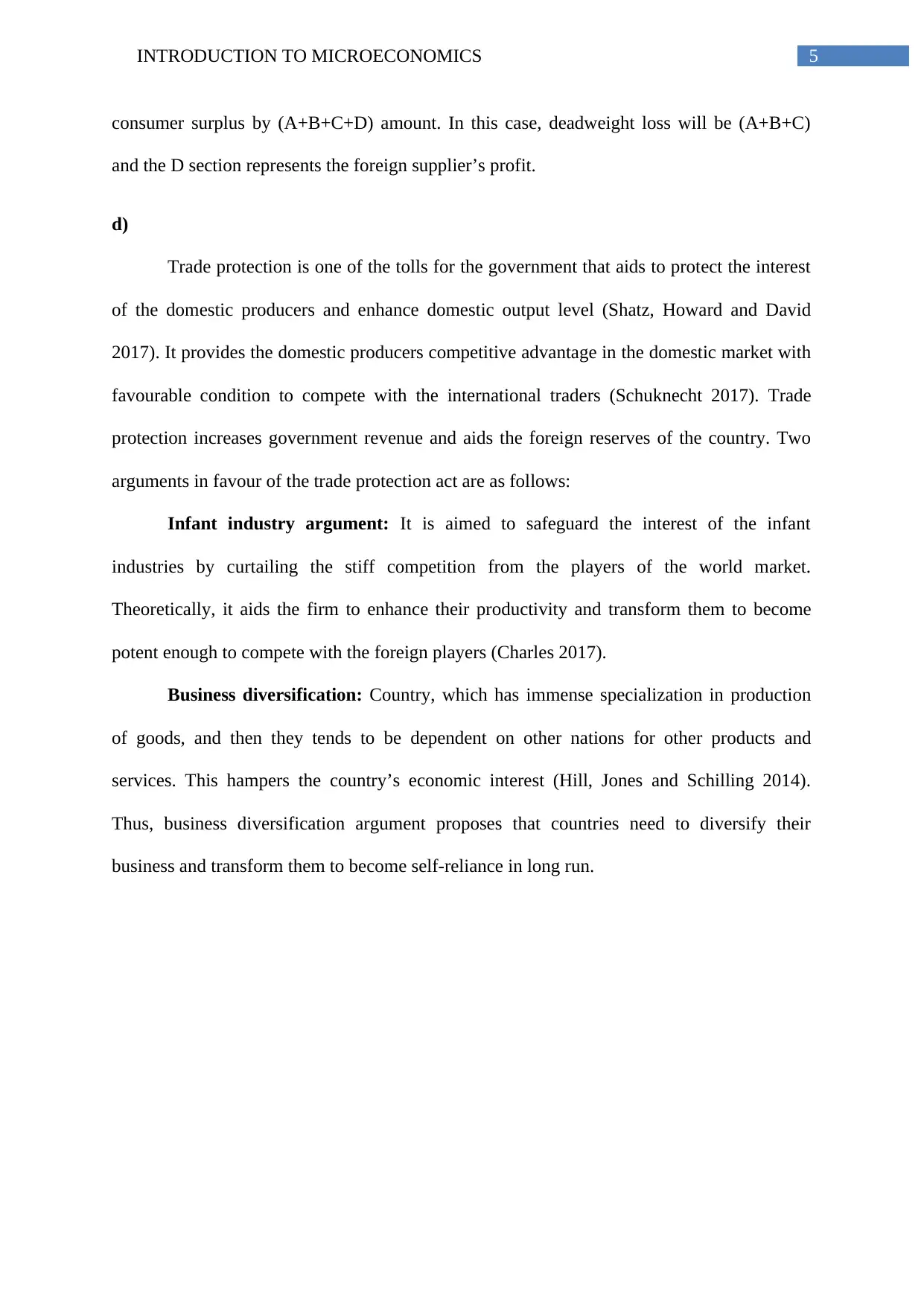
5INTRODUCTION TO MICROECONOMICS
consumer surplus by (A+B+C+D) amount. In this case, deadweight loss will be (A+B+C)
and the D section represents the foreign supplier’s profit.
d)
Trade protection is one of the tolls for the government that aids to protect the interest
of the domestic producers and enhance domestic output level (Shatz, Howard and David
2017). It provides the domestic producers competitive advantage in the domestic market with
favourable condition to compete with the international traders (Schuknecht 2017). Trade
protection increases government revenue and aids the foreign reserves of the country. Two
arguments in favour of the trade protection act are as follows:
Infant industry argument: It is aimed to safeguard the interest of the infant
industries by curtailing the stiff competition from the players of the world market.
Theoretically, it aids the firm to enhance their productivity and transform them to become
potent enough to compete with the foreign players (Charles 2017).
Business diversification: Country, which has immense specialization in production
of goods, and then they tends to be dependent on other nations for other products and
services. This hampers the country’s economic interest (Hill, Jones and Schilling 2014).
Thus, business diversification argument proposes that countries need to diversify their
business and transform them to become self-reliance in long run.
consumer surplus by (A+B+C+D) amount. In this case, deadweight loss will be (A+B+C)
and the D section represents the foreign supplier’s profit.
d)
Trade protection is one of the tolls for the government that aids to protect the interest
of the domestic producers and enhance domestic output level (Shatz, Howard and David
2017). It provides the domestic producers competitive advantage in the domestic market with
favourable condition to compete with the international traders (Schuknecht 2017). Trade
protection increases government revenue and aids the foreign reserves of the country. Two
arguments in favour of the trade protection act are as follows:
Infant industry argument: It is aimed to safeguard the interest of the infant
industries by curtailing the stiff competition from the players of the world market.
Theoretically, it aids the firm to enhance their productivity and transform them to become
potent enough to compete with the foreign players (Charles 2017).
Business diversification: Country, which has immense specialization in production
of goods, and then they tends to be dependent on other nations for other products and
services. This hampers the country’s economic interest (Hill, Jones and Schilling 2014).
Thus, business diversification argument proposes that countries need to diversify their
business and transform them to become self-reliance in long run.
⊘ This is a preview!⊘
Do you want full access?
Subscribe today to unlock all pages.

Trusted by 1+ million students worldwide
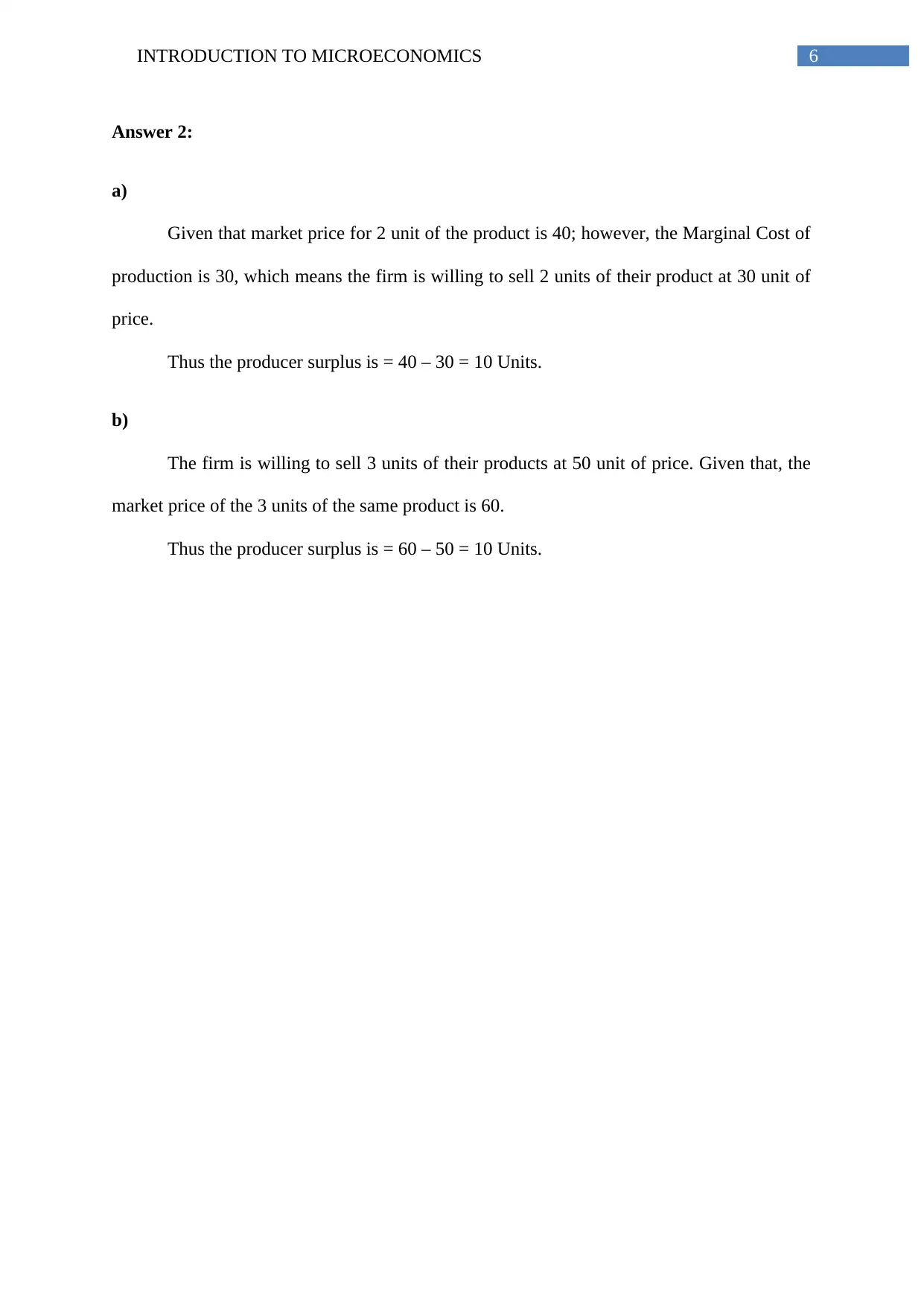
6INTRODUCTION TO MICROECONOMICS
Answer 2:
a)
Given that market price for 2 unit of the product is 40; however, the Marginal Cost of
production is 30, which means the firm is willing to sell 2 units of their product at 30 unit of
price.
Thus the producer surplus is = 40 – 30 = 10 Units.
b)
The firm is willing to sell 3 units of their products at 50 unit of price. Given that, the
market price of the 3 units of the same product is 60.
Thus the producer surplus is = 60 – 50 = 10 Units.
Answer 2:
a)
Given that market price for 2 unit of the product is 40; however, the Marginal Cost of
production is 30, which means the firm is willing to sell 2 units of their product at 30 unit of
price.
Thus the producer surplus is = 40 – 30 = 10 Units.
b)
The firm is willing to sell 3 units of their products at 50 unit of price. Given that, the
market price of the 3 units of the same product is 60.
Thus the producer surplus is = 60 – 50 = 10 Units.
Paraphrase This Document
Need a fresh take? Get an instant paraphrase of this document with our AI Paraphraser
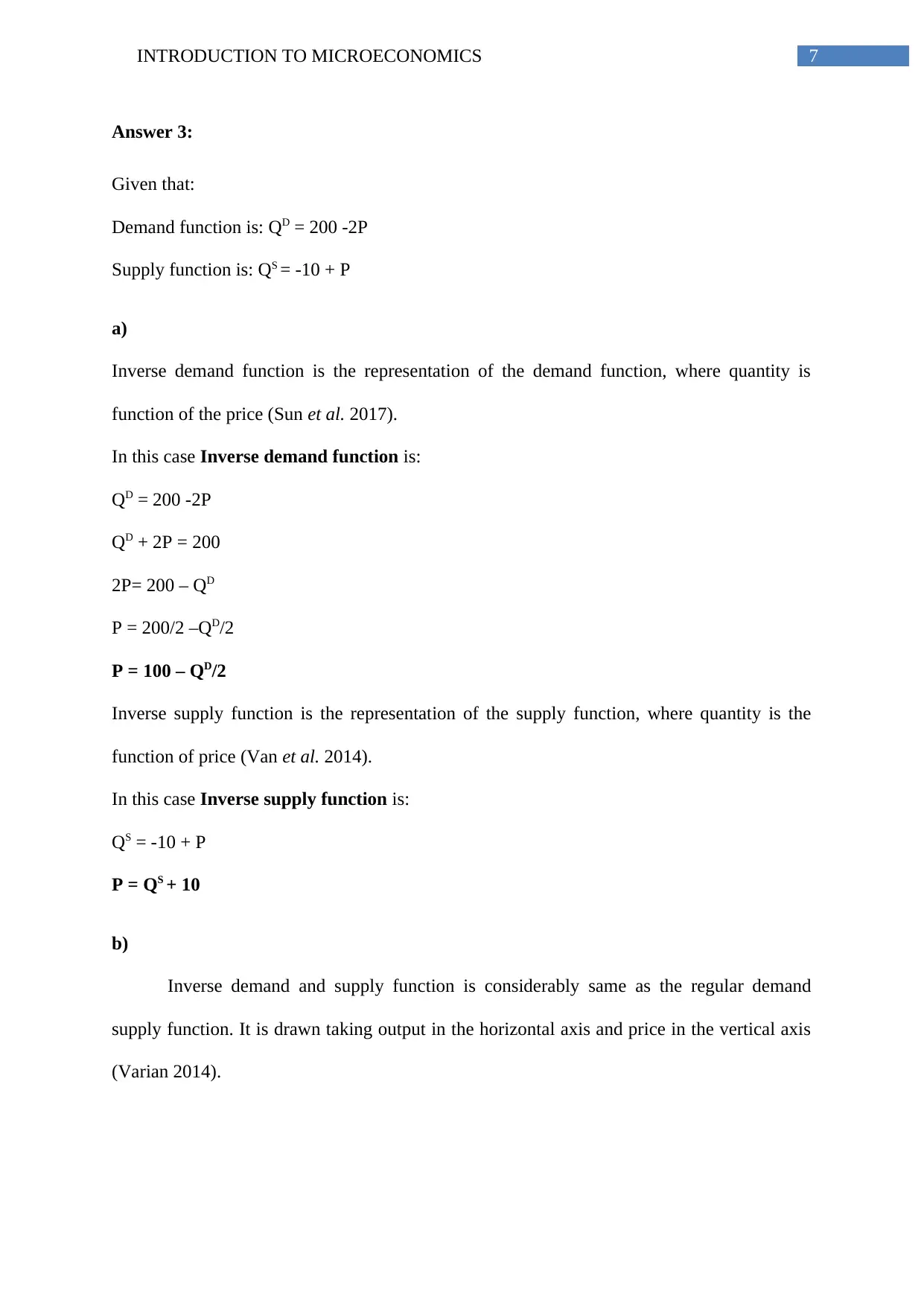
7INTRODUCTION TO MICROECONOMICS
Answer 3:
Given that:
Demand function is: QD = 200 -2P
Supply function is: QS = -10 + P
a)
Inverse demand function is the representation of the demand function, where quantity is
function of the price (Sun et al. 2017).
In this case Inverse demand function is:
QD = 200 -2P
QD + 2P = 200
2P= 200 – QD
P = 200/2 –QD/2
P = 100 – QD/2
Inverse supply function is the representation of the supply function, where quantity is the
function of price (Van et al. 2014).
In this case Inverse supply function is:
QS = -10 + P
P = QS + 10
b)
Inverse demand and supply function is considerably same as the regular demand
supply function. It is drawn taking output in the horizontal axis and price in the vertical axis
(Varian 2014).
Answer 3:
Given that:
Demand function is: QD = 200 -2P
Supply function is: QS = -10 + P
a)
Inverse demand function is the representation of the demand function, where quantity is
function of the price (Sun et al. 2017).
In this case Inverse demand function is:
QD = 200 -2P
QD + 2P = 200
2P= 200 – QD
P = 200/2 –QD/2
P = 100 – QD/2
Inverse supply function is the representation of the supply function, where quantity is the
function of price (Van et al. 2014).
In this case Inverse supply function is:
QS = -10 + P
P = QS + 10
b)
Inverse demand and supply function is considerably same as the regular demand
supply function. It is drawn taking output in the horizontal axis and price in the vertical axis
(Varian 2014).
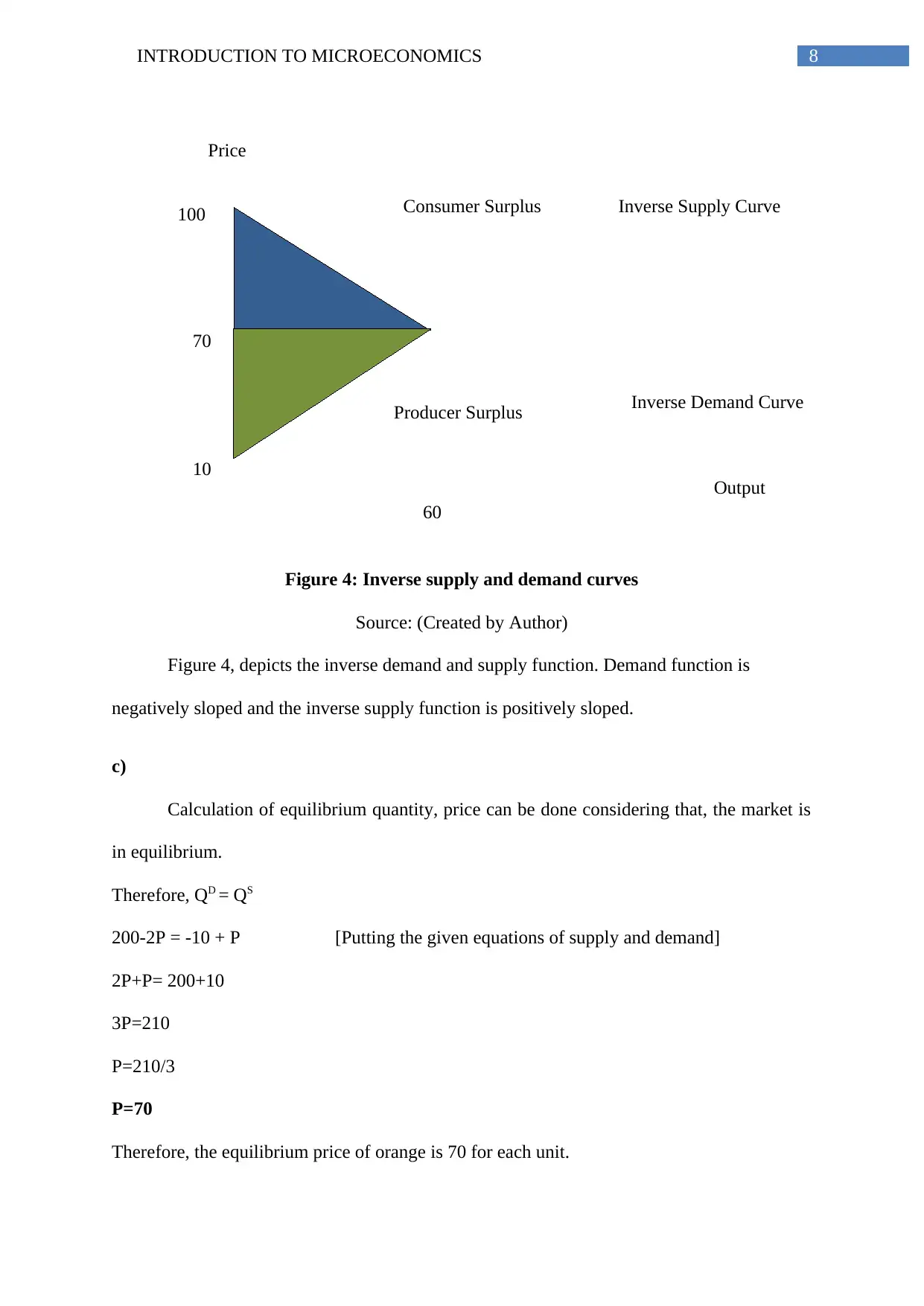
8INTRODUCTION TO MICROECONOMICS
60
70
Inverse Supply Curve
Inverse Demand Curve
Output
Price
Consumer Surplus
Producer Surplus
100
10
Figure 4: Inverse supply and demand curves
Source: (Created by Author)
Figure 4, depicts the inverse demand and supply function. Demand function is
negatively sloped and the inverse supply function is positively sloped.
c)
Calculation of equilibrium quantity, price can be done considering that, the market is
in equilibrium.
Therefore, QD = QS
200-2P = -10 + P [Putting the given equations of supply and demand]
2P+P= 200+10
3P=210
P=210/3
P=70
Therefore, the equilibrium price of orange is 70 for each unit.
60
70
Inverse Supply Curve
Inverse Demand Curve
Output
Price
Consumer Surplus
Producer Surplus
100
10
Figure 4: Inverse supply and demand curves
Source: (Created by Author)
Figure 4, depicts the inverse demand and supply function. Demand function is
negatively sloped and the inverse supply function is positively sloped.
c)
Calculation of equilibrium quantity, price can be done considering that, the market is
in equilibrium.
Therefore, QD = QS
200-2P = -10 + P [Putting the given equations of supply and demand]
2P+P= 200+10
3P=210
P=210/3
P=70
Therefore, the equilibrium price of orange is 70 for each unit.
⊘ This is a preview!⊘
Do you want full access?
Subscribe today to unlock all pages.

Trusted by 1+ million students worldwide
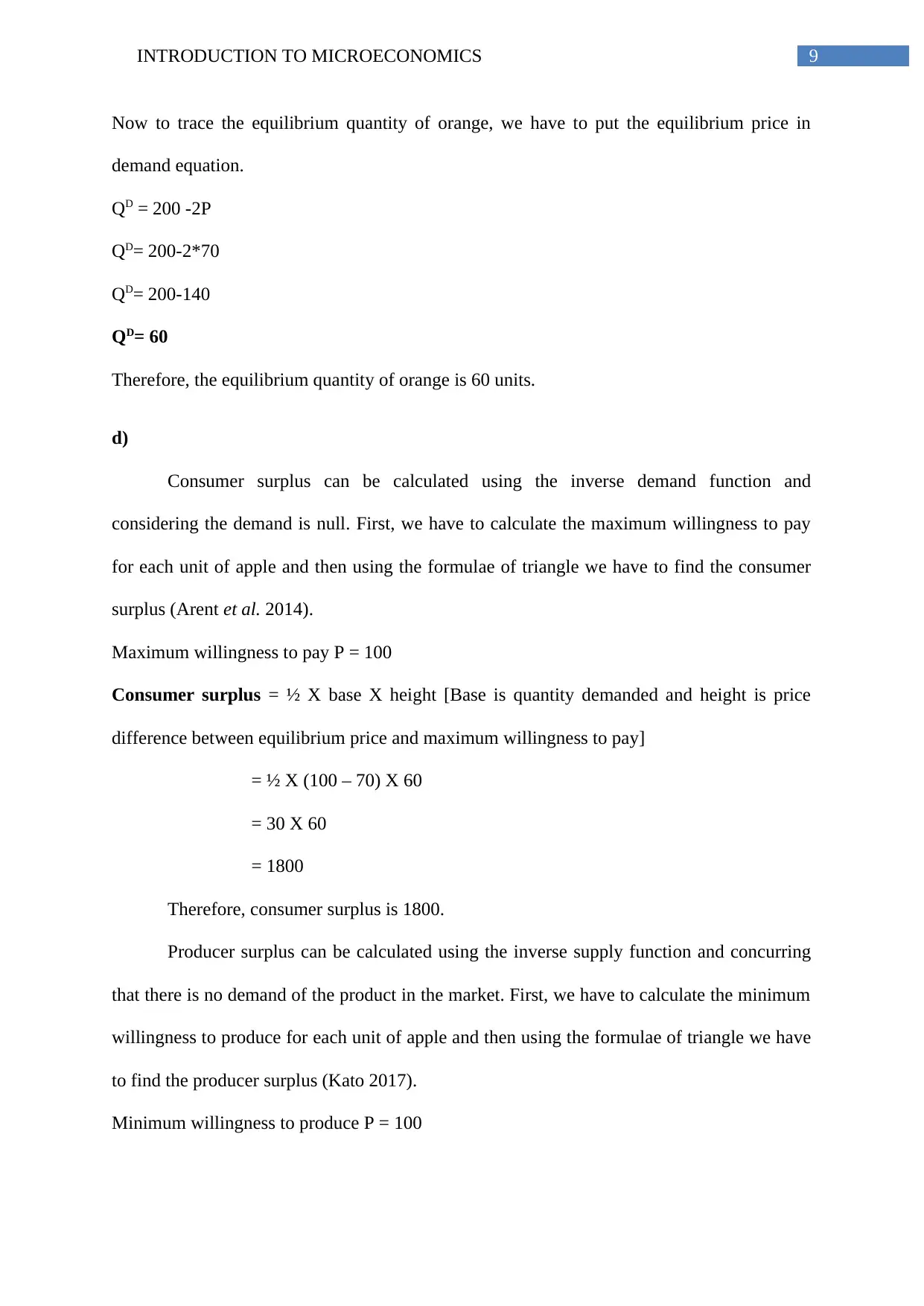
9INTRODUCTION TO MICROECONOMICS
Now to trace the equilibrium quantity of orange, we have to put the equilibrium price in
demand equation.
QD = 200 -2P
QD= 200-2*70
QD= 200-140
QD= 60
Therefore, the equilibrium quantity of orange is 60 units.
d)
Consumer surplus can be calculated using the inverse demand function and
considering the demand is null. First, we have to calculate the maximum willingness to pay
for each unit of apple and then using the formulae of triangle we have to find the consumer
surplus (Arent et al. 2014).
Maximum willingness to pay P = 100
Consumer surplus = ½ X base X height [Base is quantity demanded and height is price
difference between equilibrium price and maximum willingness to pay]
= ½ X (100 – 70) X 60
= 30 X 60
= 1800
Therefore, consumer surplus is 1800.
Producer surplus can be calculated using the inverse supply function and concurring
that there is no demand of the product in the market. First, we have to calculate the minimum
willingness to produce for each unit of apple and then using the formulae of triangle we have
to find the producer surplus (Kato 2017).
Minimum willingness to produce P = 100
Now to trace the equilibrium quantity of orange, we have to put the equilibrium price in
demand equation.
QD = 200 -2P
QD= 200-2*70
QD= 200-140
QD= 60
Therefore, the equilibrium quantity of orange is 60 units.
d)
Consumer surplus can be calculated using the inverse demand function and
considering the demand is null. First, we have to calculate the maximum willingness to pay
for each unit of apple and then using the formulae of triangle we have to find the consumer
surplus (Arent et al. 2014).
Maximum willingness to pay P = 100
Consumer surplus = ½ X base X height [Base is quantity demanded and height is price
difference between equilibrium price and maximum willingness to pay]
= ½ X (100 – 70) X 60
= 30 X 60
= 1800
Therefore, consumer surplus is 1800.
Producer surplus can be calculated using the inverse supply function and concurring
that there is no demand of the product in the market. First, we have to calculate the minimum
willingness to produce for each unit of apple and then using the formulae of triangle we have
to find the producer surplus (Kato 2017).
Minimum willingness to produce P = 100
Paraphrase This Document
Need a fresh take? Get an instant paraphrase of this document with our AI Paraphraser
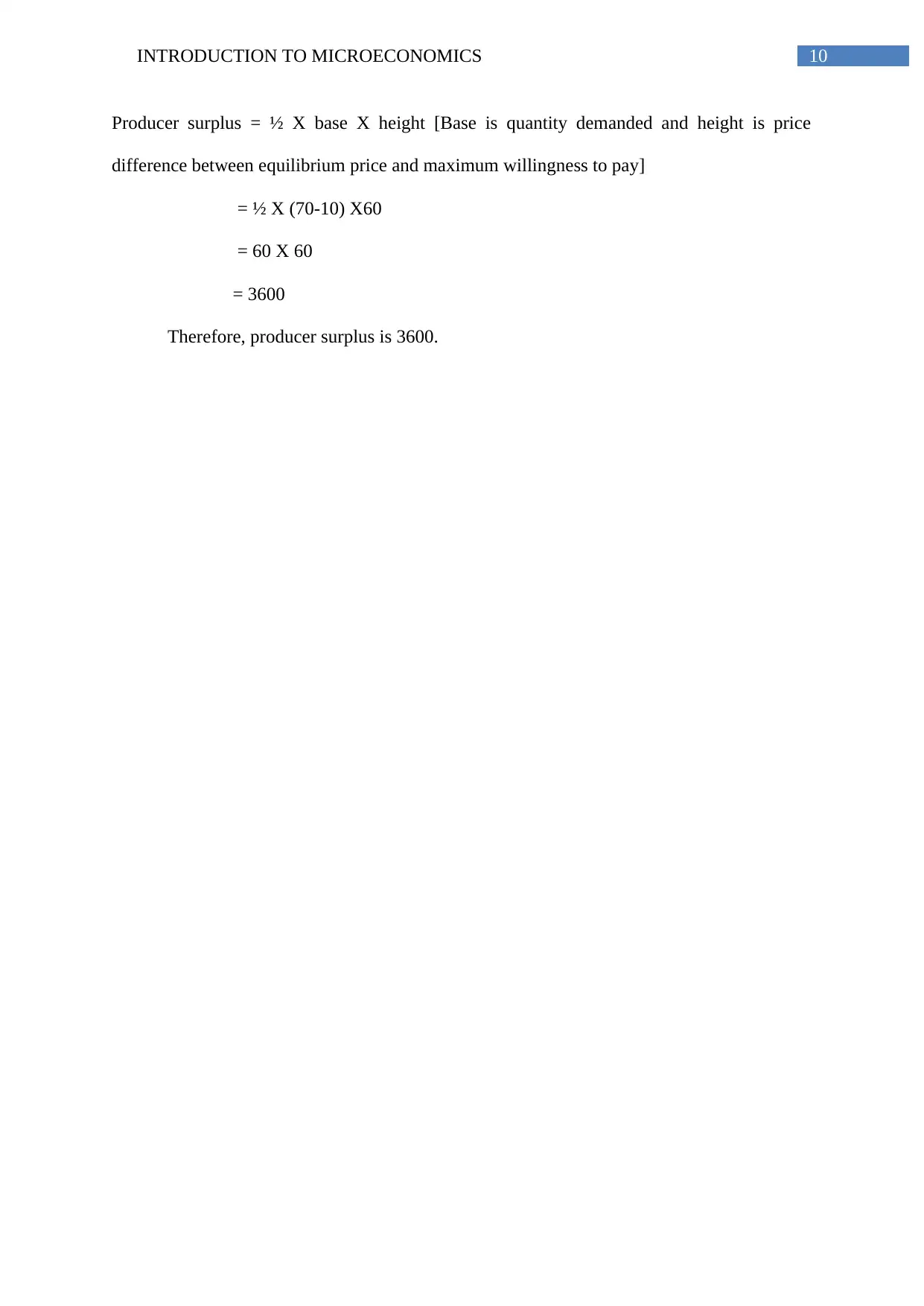
10INTRODUCTION TO MICROECONOMICS
Producer surplus = ½ X base X height [Base is quantity demanded and height is price
difference between equilibrium price and maximum willingness to pay]
= ½ X (70-10) X60
= 60 X 60
= 3600
Therefore, producer surplus is 3600.
Producer surplus = ½ X base X height [Base is quantity demanded and height is price
difference between equilibrium price and maximum willingness to pay]
= ½ X (70-10) X60
= 60 X 60
= 3600
Therefore, producer surplus is 3600.
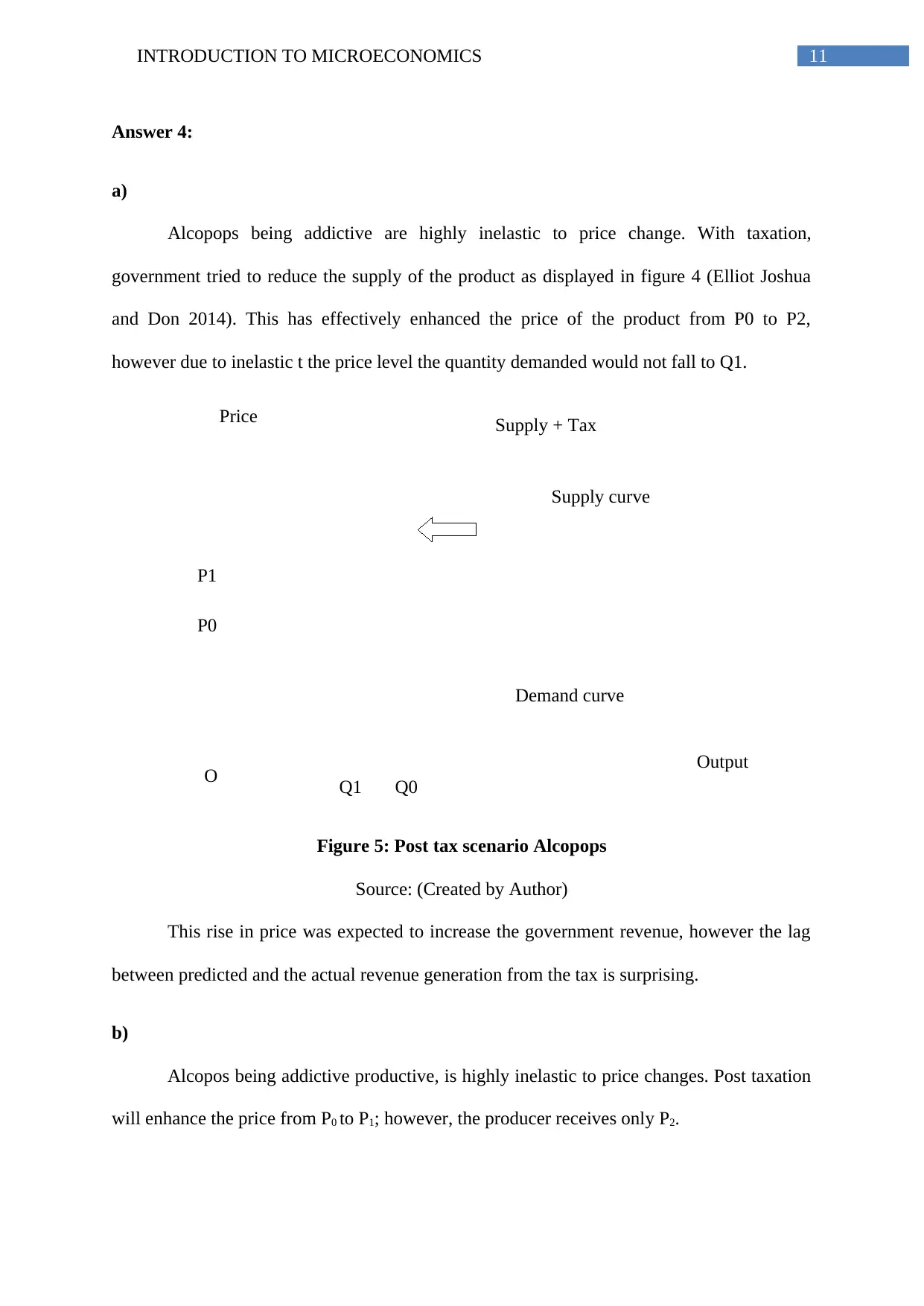
11INTRODUCTION TO MICROECONOMICS
Price
O Output
Demand curve
Supply curve
Supply + Tax
Q1 Q0
P1
P0
Answer 4:
a)
Alcopops being addictive are highly inelastic to price change. With taxation,
government tried to reduce the supply of the product as displayed in figure 4 (Elliot Joshua
and Don 2014). This has effectively enhanced the price of the product from P0 to P2,
however due to inelastic t the price level the quantity demanded would not fall to Q1.
Figure 5: Post tax scenario Alcopops
Source: (Created by Author)
This rise in price was expected to increase the government revenue, however the lag
between predicted and the actual revenue generation from the tax is surprising.
b)
Alcopos being addictive productive, is highly inelastic to price changes. Post taxation
will enhance the price from P0 to P1; however, the producer receives only P2.
Price
O Output
Demand curve
Supply curve
Supply + Tax
Q1 Q0
P1
P0
Answer 4:
a)
Alcopops being addictive are highly inelastic to price change. With taxation,
government tried to reduce the supply of the product as displayed in figure 4 (Elliot Joshua
and Don 2014). This has effectively enhanced the price of the product from P0 to P2,
however due to inelastic t the price level the quantity demanded would not fall to Q1.
Figure 5: Post tax scenario Alcopops
Source: (Created by Author)
This rise in price was expected to increase the government revenue, however the lag
between predicted and the actual revenue generation from the tax is surprising.
b)
Alcopos being addictive productive, is highly inelastic to price changes. Post taxation
will enhance the price from P0 to P1; however, the producer receives only P2.
⊘ This is a preview!⊘
Do you want full access?
Subscribe today to unlock all pages.

Trusted by 1+ million students worldwide
1 out of 15
Related Documents
Your All-in-One AI-Powered Toolkit for Academic Success.
+13062052269
info@desklib.com
Available 24*7 on WhatsApp / Email
![[object Object]](/_next/static/media/star-bottom.7253800d.svg)
Unlock your academic potential
Copyright © 2020–2025 A2Z Services. All Rights Reserved. Developed and managed by ZUCOL.





